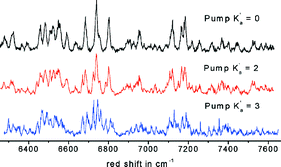Probing spin–orbit mixing and the singlet–triplet gap in dichloromethylene via Ka-sorted emission spectra
Abstract
The magnitude of the singlet–triplet gap in dichloromethylene (CCl2) has been a point of controversy in the recent literature. In this study, we report single vibronic level ![[X with combining tilde]](https://www.rsc.org/images/entities/i_char_0058_0303.gif) 1A1 system of the
1A1 system of the ![[X with combining tilde]](https://www.rsc.org/images/entities/i_char_0058_0303.gif) 1A1 state up to ≈10 000 cm−1 above the vibrationless level. By the careful selection of bands where complete isotope and Ka′ selectivity in excitation was possible, we measured Ka′-sorted
1A1 state up to ≈10 000 cm−1 above the vibrationless level. By the careful selection of bands where complete isotope and Ka′ selectivity in excitation was possible, we measured Ka′-sorted ![[B with combining macron]](https://www.rsc.org/images/entities/i_char_0042_0304.gif) ″) rotational constant, which is significantly larger for pure triplet levels due to the larger equilibrium bond angle. In the region between 3500 and 9000 cm−1 above the vibrationless level of the
″) rotational constant, which is significantly larger for pure triplet levels due to the larger equilibrium bond angle. In the region between 3500 and 9000 cm−1 above the vibrationless level of the ![[X with combining tilde]](https://www.rsc.org/images/entities/i_char_0058_0303.gif) 1A1 state, we find only a very modest increase in (A″
−
1A1 state, we find only a very modest increase in (A″
−
![[B with combining macron]](https://www.rsc.org/images/entities/i_char_0042_0304.gif) ″), and ∼86% of the lines observed between 5000 and 9000 cm−1 can be assigned to
″), and ∼86% of the lines observed between 5000 and 9000 cm−1 can be assigned to ![[X with combining tilde]](https://www.rsc.org/images/entities/i_char_0058_0303.gif) 1A1 levels within 3 standard deviations of our Dunham expansion fit, which included more than 140 levels in total. A nearly complete set of Dunham parameters was determined for the C35Cl2 isotopomer, and the
1A1 levels within 3 standard deviations of our Dunham expansion fit, which included more than 140 levels in total. A nearly complete set of Dunham parameters was determined for the C35Cl2 isotopomer, and the ![[X with combining tilde]](https://www.rsc.org/images/entities/i_char_0058_0303.gif) 1A1 state term energies up to 4000 cm−1 are in excellent agreement with recent variational calculations of Tarczay, et al. [G. Tarczay, T. A. Miller, G, Czakó and A. G. Császár, Phys. Chem. Chem. Phys., 2005, 7, 2881]. Finally, the implication of our results for the singlet–triplet gap in dichloromethylene is discussed.
1A1 state term energies up to 4000 cm−1 are in excellent agreement with recent variational calculations of Tarczay, et al. [G. Tarczay, T. A. Miller, G, Czakó and A. G. Császár, Phys. Chem. Chem. Phys., 2005, 7, 2881]. Finally, the implication of our results for the singlet–triplet gap in dichloromethylene is discussed.


 Please wait while we load your content...
Please wait while we load your content...